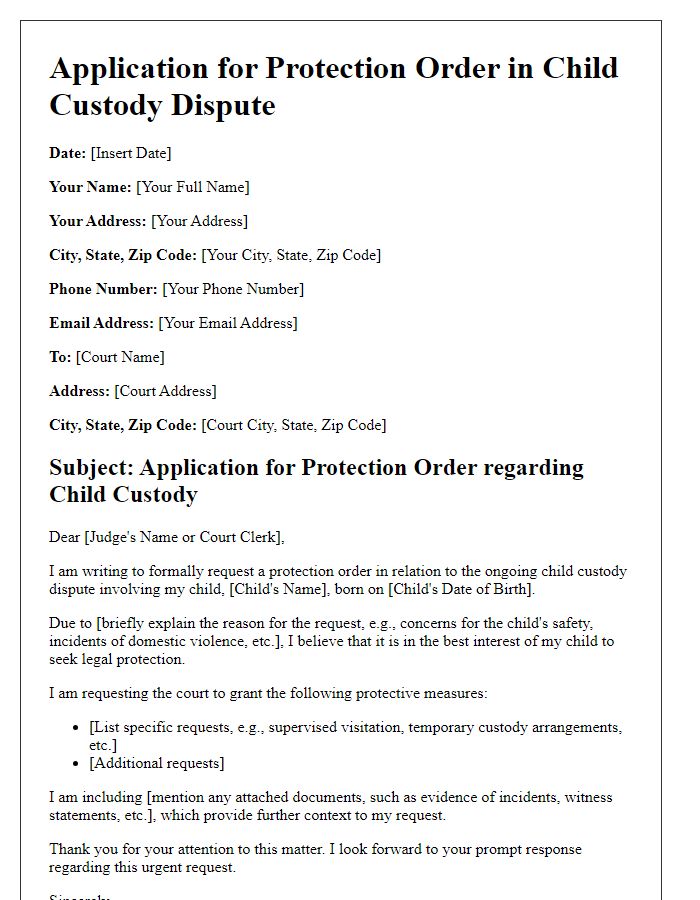If you're considering a protection order, it's essential to understand the process and requirements involved. A well-crafted letter can serve as a crucial component of your application, outlining your circumstances clearly and concisely. In this article, we'll guide you through creating a compelling letter template that reflects your situation, ensuring your voice and concerns are heard. Ready to take the next step toward your safety? Let's dive in and explore how to write an effective protection order application letter!

Applicant's personal information
The applicant's personal information, vital for a protection order application, includes full name, current residential address, date of birth, and contact number. This data ensures proper identification and facilitates communication throughout the legal process. Accurate information about any previous addresses offers insight into the applicant's living situations, potentially relevant for assessing safety concerns. Additional details such as relationships with respondents, including history of conflict or harassment events, can provide essential context for the court's understanding of the situation. Furthermore, personal identification numbers, like driver's license or social security numbers, may be included to authenticate the applicant's identity officially.
Details of the respondent
The respondent in a protection order application refers to the individual against whom the order is being sought, typically due to allegations of harassment, threats, or violence. Essential details include full name, date of birth (including age), physical address (where the respondent is believed to reside), and any known aliases or nicknames. Additionally, contact information such as phone numbers and email addresses can be significant identifier elements. Prior incidents involving law enforcement or legal actions related to the respondent should also be documented for context. Personal characteristics such as gender, race, and physical description, including height and weight, can further assist authorities in accurately identifying the respondent.
Description of incidents and evidence
Detailed descriptions of incidents in protection order applications include various events, such as instances of harassment, physical assault, or threats of violence. Each incident should clearly outline the date and location, for example, "On January 15, 2023, at approximately 7 PM, at 123 Maple Street, the respondent approached the applicant aggressively." Evidence compiled could consist of photographs depicting injuries, text messages or emails that demonstrate threats or intimidation, witness statements from individuals present during incidents, and police reports documenting past calls made to law enforcement regarding disturbances. This comprehensive collection of information serves to illustrate the ongoing nature of the threat and the necessity of legal protection.
Legal requirements and jurisdiction
Protection order applications require specific legal requirements depending on the jurisdiction, such as state or country. Applicants must typically submit a written request outlining the reasons for the protection order, citing incidents of domestic violence, harassment, or stalking. The application may necessitate details including dates, locations, and descriptions of incidents to establish a pattern of behavior. Some jurisdictions impose filing fees, while others may allow fee waivers based on the applicant's financial status. Jurisdictions often have specific courts designated to handle these applications, such as family courts or specialized domestic violence courts, ensuring that cases are reviewed by judges with expertise in these sensitive matters. Applications usually need to be filed within a specified time frame following the last incident, and hearing dates are often set to allow for a swift judicial response to urgent safety concerns.
Urgent relief and protection measures requested
In cases of domestic violence, the need for protection orders becomes critical for ensuring safety and security. A protection order application often requires immediate intervention from local courts, such as the Family Court in various jurisdictions. Victims may seek urgent relief due to threats, harassment, or physical assaults, citing specific incidents--dates, times, and locations--where these events occurred. Protective measures requested may include no-contact orders, temporary custody arrangements for children, and exclusive possession of shared residences. Victims may also request direct police involvement in enforcing these orders, emphasizing the importance of timely action to prevent further harm and ensure ongoing protection. Documentation such as police reports or witness statements can bolster the application's validity in court.
Letter Template For Protection Order Applications Samples
Letter template of protection order request for domestic violence victims.

Letter template of protection order petition for vulnerable individuals.

Letter template of protection order application for child custody disputes.











Comments